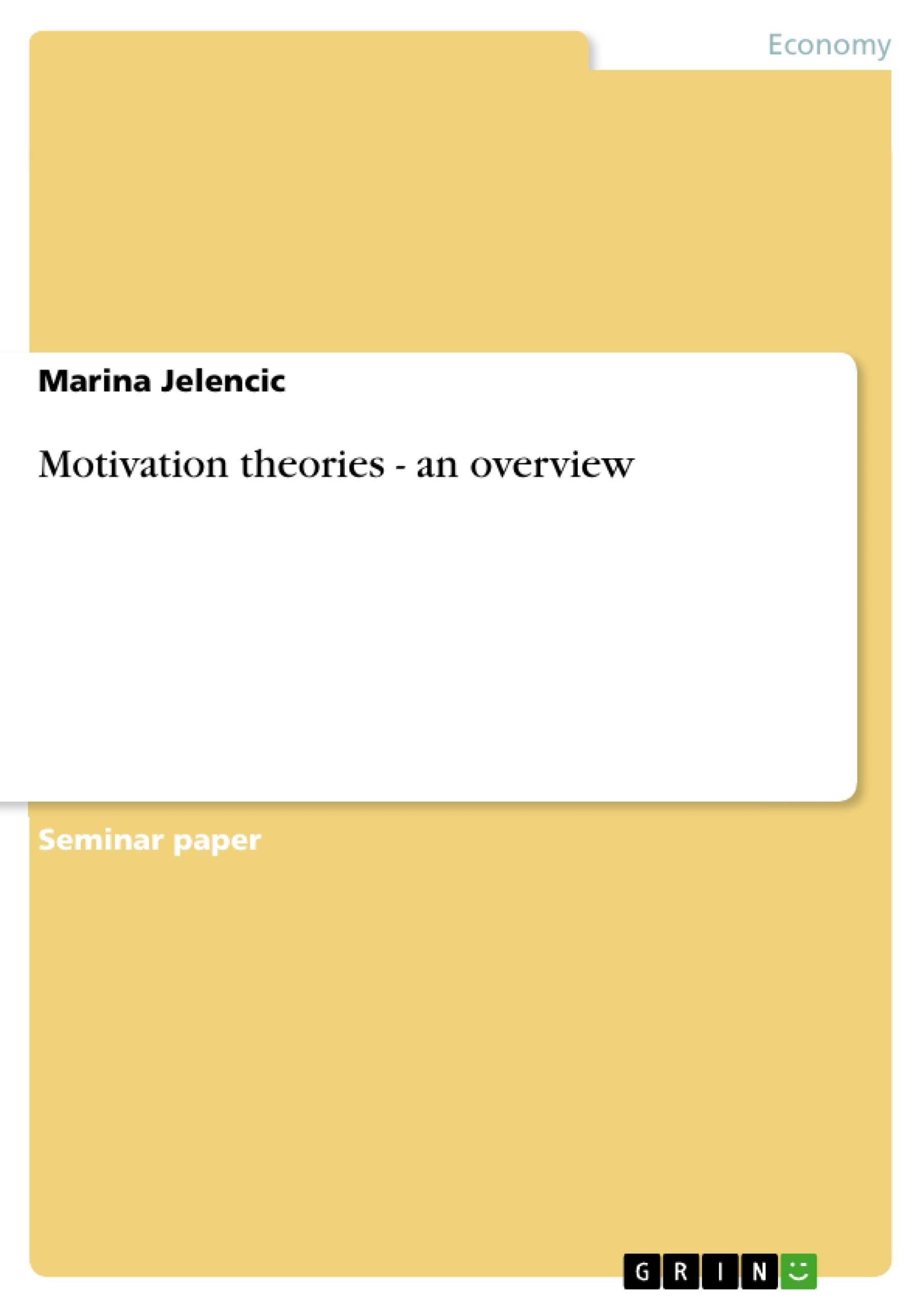In today's economic situation the survival and the success of a company depends not insignificantly on its productivity and innovation capability. The most important source of innovation is every individual employee in the company. High productivity in turn depends not only on modern technology but also on the individual attitude of the employees. Beyond doubt, an employee who is willing to involve himself and who can identify with the objectives of the company is significantly more productive and innovative than one employee who only looks at the clock and awaits the knocking-off time.
Over the past years, the term “motivation” became a central point of discussions about leadership and cooperation. For the one side, motivation is a contemporary motivational technique that eliminates the need for authoritarian leadership, while others disapprove it because they think it is a tool for manipulation or exploitation.
Inhaltsverzeichnis (Table of Contents)
- 1. Introduction
- 2. Terms
- 2.1 Motivation
- 2.1.1 Intrinsic motivation
- 2.1.2 Extrinsic motivation
- 3. Motivation Theories
- 3.1 Maslow's hierarchy of needs
- 3.2 Alderfer's ERG- theory
- 3.3 Herzberg's two factor theory
- 3.4 McClelland's acquired needs theory
- 4. Conclusion
Zielsetzung und Themenschwerpunkte (Objectives and Key Themes)
This text aims to provide a summary of prominent motivation theories within the context of modern management and their relevance to employee productivity and innovation. The text explores how understanding these theories is crucial for effective human resource management.
- The importance of employee motivation in organizational success
- Different approaches to understanding and fostering employee motivation
- The role of motivation theories in modern human resource management
- Distinctions between intrinsic and extrinsic motivation
- Overview of several key motivation theories (Maslow, Alderfer, Herzberg, McClelland)
Zusammenfassung der Kapitel (Chapter Summaries)
1. Introduction: This introductory chapter establishes the critical link between employee motivation, productivity, and innovation within the context of contemporary business. It highlights the increasing focus on motivation as a key element of successful leadership and effective cooperation, contrasting it with potentially manipulative or exploitative interpretations. The chapter emphasizes the significance of motivation theories in modern human resource management, setting the stage for a detailed exploration of key theories in subsequent sections.
2. Terms: This chapter defines the core concept of "motivation," exploring various interpretations and highlighting the distinction between intrinsic and extrinsic motivation. It presents multiple definitions of motivation, illustrating the multifaceted nature of the concept. The section then differentiates between intrinsic motivation (driven by internal factors like enjoyment and satisfaction) and extrinsic motivation (driven by external rewards like money or grades), laying the groundwork for understanding the nuances of motivational influences.
3. Motivation Theories: This chapter delves into several influential motivation theories, providing an overview of their core tenets and implications. The chapter likely discusses Maslow's hierarchy of needs, Alderfer's ERG theory, Herzberg's two-factor theory, and McClelland's acquired needs theory, analyzing each theory's contribution to the understanding of human motivation and its application in organizational contexts. Each theory likely presents a different perspective on what drives individuals to work and achieve, and the chapter would synthesize these perspectives.
Schlüsselwörter (Keywords)
Motivation, intrinsic motivation, extrinsic motivation, Maslow's hierarchy of needs, Alderfer's ERG theory, Herzberg's two-factor theory, McClelland's acquired needs theory, employee productivity, innovation, human resource management, organizational success, leadership, cooperation.
Frequently Asked Questions: A Comprehensive Language Preview of Motivation Theories
What is the purpose of this text?
This text provides a comprehensive overview of prominent motivation theories within the context of modern management. It explores the relevance of these theories to employee productivity and innovation, emphasizing their crucial role in effective human resource management.
What topics are covered in the text?
The text covers the following key areas: the importance of employee motivation in organizational success; different approaches to understanding and fostering employee motivation; the role of motivation theories in modern human resource management; the distinction between intrinsic and extrinsic motivation; and an overview of several key motivation theories (Maslow, Alderfer, Herzberg, McClelland).
What are the key motivation theories discussed?
The text delves into Maslow's hierarchy of needs, Alderfer's ERG theory, Herzberg's two-factor theory, and McClelland's acquired needs theory. Each theory is examined for its contribution to understanding human motivation and its application in organizational settings.
What is the difference between intrinsic and extrinsic motivation?
The text clearly differentiates between intrinsic motivation (driven by internal factors like enjoyment and satisfaction) and extrinsic motivation (driven by external rewards like money or grades). This distinction is fundamental to understanding the nuances of motivational influences.
How is the text structured?
The text is structured into chapters: an introduction establishing the importance of employee motivation; a chapter defining key terms, including intrinsic and extrinsic motivation; a chapter dedicated to exploring several key motivation theories; and a concluding chapter. It also includes a table of contents, objectives and key themes, chapter summaries, and keywords.
What is the significance of motivation theories in human resource management?
The text highlights that understanding motivation theories is crucial for effective human resource management. Applying these theories allows for better strategies in employee engagement, performance improvement, and fostering a productive and innovative work environment.
What are the key takeaways from the text?
The key takeaways emphasize the critical link between employee motivation, productivity, and innovation. The text stresses the multifaceted nature of motivation and the importance of understanding both intrinsic and extrinsic factors in driving employee performance and organizational success.
What are the keywords associated with this text?
The keywords include: Motivation, intrinsic motivation, extrinsic motivation, Maslow's hierarchy of needs, Alderfer's ERG theory, Herzberg's two-factor theory, McClelland's acquired needs theory, employee productivity, innovation, human resource management, organizational success, leadership, and cooperation.
- Citation du texte
- Marina Jelencic (Auteur), 2010, Motivation theories - an overview, Munich, GRIN Verlag, https://www.grin.com/document/171355



